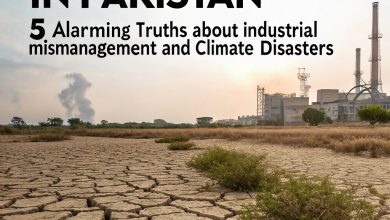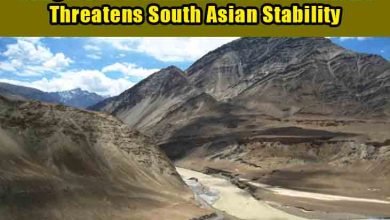Cholistan Canal Controversy: Water Crisis And Environmental Risks In Pakistan
Pakistan’s $3.3 billion Green Pakistan Initiative (GPI) aims to develop six canals to irrigate millions of acres of barren land. However, the project has met with fierce opposition from Sindh, with concerns over water distribution inequality and ecological damage. The most contentious project is the 176 km Cholistan Canal in Punjab, which could exacerbate Sindh’s water crisis and trigger long-term environmental damage.
The Green Pakistan Initiative and Controversy Surrounding Cholistan Canal
The Green Pakistan Initiative, launched with a budget of $3.3 billion, seeks to enhance Pakistan’s agricultural productivity by constructing six canals. The most debated of these is the Cholistan Canal, expected to be completed by 2030 with an estimated cost of $783 million.
This canal will draw water from the Indus Basin Irrigation System (IBIS), with floodwaters utilized for four months annually and river water from Punjab during the remaining months. However, this arrangement has raised concerns among Sindhi nationalists and political parties, especially the Pakistan People’s Party (PPP), which organized protests against the canal. The Sindh Assembly has also passed a resolution opposing the project.
Historical Water Disputes Between Punjab and Sindh
Water allocation disputes between Punjab and Sindh date back over a century. The conflict began in 1901 when the Indian Irrigation Commission restricted Punjab’s water use without Sindh’s consent. This dispute intensified in 1919 when Punjab was barred from initiating irrigation projects until Sindh’s concerns were addressed.
A British Indian government report mandated the construction of the Sukkur Barrage as a precondition for future irrigation developments in Punjab. However, disagreements over water distribution have continued to plague relations between the provinces.
Environmental Risks Posed by the Cholistan Canal
The Indus Basin Irrigation System (IBIS) is one of the largest irrigation networks globally, supporting approximately 44 million acres of farmland. Excessive water diversion and climate change have significantly strained the system, jeopardizing the ecological balance of the Indus Delta.
Historically, the Indus River discharged around 80 million-acre feet (MAF) of water into the Arabian Sea. However, annual outflows have fallen below 1 MAF, causing intensified seawater intrusion and land degradation. The once-thriving Indus Delta, home to the world’s seventh-largest mangrove forest, is shrinking rapidly, exacerbating coastal erosion and endangering marine biodiversity.
Socio-Economic Implications
Coastal communities are particularly vulnerable, with over 1.3 million acres of fertile land turning barren due to saltwater intrusion. Farmers are abandoning their lands, prompting climate-induced migration and worsening socio-economic instability. The fishing industry, a critical economic pillar, has also been severely impacted by declining freshwater inflows and mangrove destruction.
The 1991 Water Apportionment Accord and Its Shortcomings
The 1991 Water Apportionment Accord aimed to distribute water resources equitably among Pakistan’s provinces, including a minimum outflow of 10 MAF downstream of the Kotri Barrage. However, this provision remains largely unimplemented due to inter-provincial disagreements.
Punjab’s extensive use of water resources for irrigation has consistently raised concerns about Sindh’s water security. The proposed Cholistan Canal is perceived by Sindh as a direct threat to its already limited water share.
Climate Change Compounding Water Challenges
Climate change has further complicated water distribution issues. Research shows a westward shift in the Indian monsoon, reducing rainfall in northeastern regions while intensifying precipitation in the west. This shift increases Sindh’s vulnerability to extreme weather events like droughts and floods.
The devastating floods of 2010, 2011, 2020, and 2022 highlight the urgent need for improved water management infrastructure. Without climate-resilient policies, Pakistan faces escalating risks to its agricultural output, food security, and socio-economic stability.
Recommended Solutions and the Way Forward
Pakistan must adopt balanced and forward-thinking strategies to ensure sustainable development and environmental conservation. This includes revisiting the 1991 Water Apportionment Accord to address current hydrological realities and climate challenges. Ensuring a minimum outflow of at least 10 MAF to the sea is crucial for ecological balance.
Instead of focusing solely on large dams, Pakistan should implement decentralised water storage solutions such as check dams and underground reservoirs. Additionally, community-led mangrove rehabilitation programs are essential for restoring coastal ecosystems and preserving biodiversity.
Conclusion
The Cholistan Canal project represents a critical test for Pakistan’s water management policies. Without a strategic, climate-adaptive approach, the country’s ecological and socio-economic stability remains at risk. A collaborative, science-based framework is essential to safeguard water resources and ensure a sustainable future for all provinces.
Meta Description
Cholistan Canal Controversy: Pakistan’s $3.3B Green Pakistan Initiative sparks opposition amid Sindh’s water crisis fears and environmental concerns. Experts urge climate-adaptive water policies.
Focus Keyword
Cholistan Canal Controversy
URL
example.com/cholistan-canal-controversy
External Links
Internal Links







